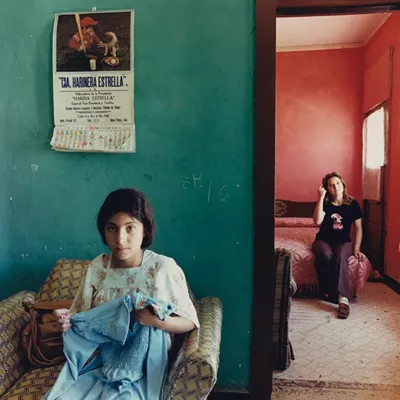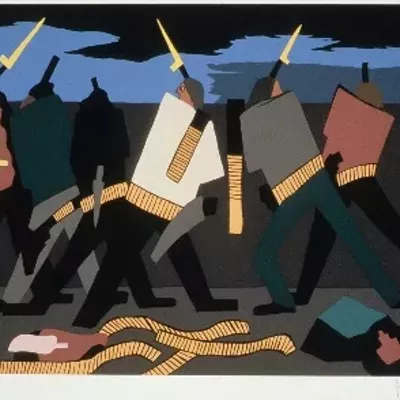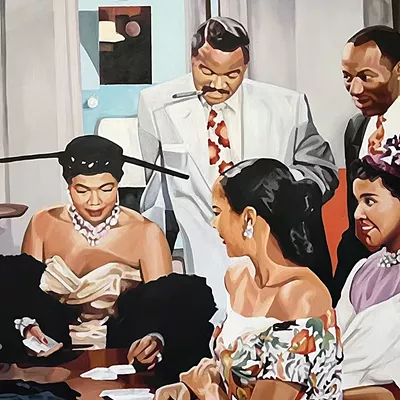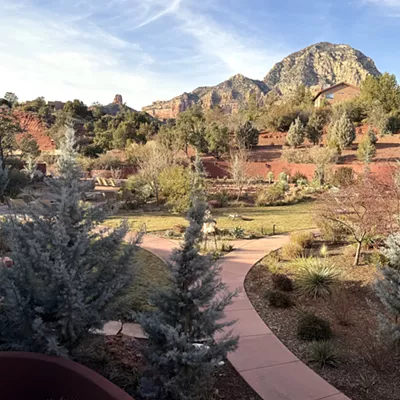AT OPPOSITE ENDS of the 20th century, Tucson benefited from the pioneering visions of architects Annie Graham Rockfellow and Judith Chafee. Between 1916 and 1938, Rockfellow designed dozens of influential public buildings, including Safford School, the El Conquistador Hotel, the Desert Sanitarium and the YWCA. With their undulating arches, carved ornament and red-tile roofs, these works helped popularize the romantic Spanish Mission Revival style.
From the 1970s through the '90s, Chafee's work was widely published and honored, but she was less well known in her hometown, where most of the commissions that came her way were for private homes. But her innovative welding of the bold forms and contemporary materials of modernism to traditional desert styles continues to influence architects today.
Though they were born 66 years apart, both women entered their field at times when architecture was considered no place for women. In the 1880s, Rockfellow became the first woman to take an architecture diploma at the Massachusetts Institute of Technology. She was part of the first wave of women architects who proliferated around the turn of the century, and then virtually disappeared by the 1940s. When Chafee studied architecture at Yale in the 1950s, she was the only woman in her class.
For both, the most important thing about architecture was the way a building fit into its landscape. And in Tucson, that meant coming to terms with desert light and heat. Though they practiced radically different architecture, they both drew on indigenous styles, from the rock dwellings of Mesa Verde to the adobe houses of the barrio.
Important as they were to Tucson, the town has not been kind to their legacy. It ignored Rockfellow's call to preserve the city's Mexican heart, it tore down her sumptuous El Conquistador Hotel, the predecessor to El Con Mall, and left her out of the history books. Chafee lived long enough to see her Blackwell House despised and leveled.
IN HER LAST years, when she was dying of emphysema, architect Judith Chafee used to drive over to an old adobe house in the center of town. She'd bring a student along to look at the place, or she'd just sit in the car by herself, lost in quiet contemplation.
The house is certainly worth looking at. The city has grown up around it -- an office strip on Campbell edges along the lot's eastern perimeter, and telephone poles mar the nearby view of the towering Catalinas. But these new degradations don't stop the house from being comfortable in its place. It sprawls across a half-acre of desert alive with creosote and prickly pear, and it seems to grow right out of the ground, twisting and turning past elderly mesquite trees, sprouting a porch roof here to keep out the sun, a second-floor balcony there to offer views of the Tucson Mountains.
This is a not a house that Judith Chafee built, at least not entirely, but it may be the house that made her.
It was Chafee's childhood home, and from it she learned two crucial lessons for the architecture that would later bring her world-wide renown. The spare house was modern in the extreme for the Tucson of the 1930s, and it co-existed easily with its harsh desert climate.
"It was one of those wonderful old Tucson houses where a room or two got added every year," Chafee told writer Lawrence Cheek years later. "It changed all the time. I could come home from school, and my mother would be moving the kitchen to another room. It was also a very modern house. It didn't look like other people's houses. It was not cutesy. The bare concrete floor, the modern furniture...There was a north patio where you could have violets, and on the west my mother built huge ramadas. One was very aware of the house's relationship to the climate."
The constant renovations gave young Judith her first chance to build. As a little kid, she would run outside in overalls to work with the Mexican and Yaqui laborers who were slapping together adobe bricks from the backyard mud. A house, in the young girl's mind, came right out of its own earth.
That was true of Chafee's grown-up architectural works as well.
"Her buildings are always part of the land," says Corky Poster, a Tucson architect who got his first job with Chafee back in 1973. Two points, he says, are key to understanding Chafee's work:
"She was an unrepentant modernist...She worked for the giants of modernism and she was an absolutely committed modernist. On the other hand, she was a product of Tucson...She grew up here in the heyday of Tucson. Her aesthetic roots are in the Sonoran Desert. More than anyone, she's practiced a blend of modernism wed to Tucson. It's a modernism bred out of the desert...(Her buildings) connect to the earth, the land, the vegetation and the surroundings."
Bob Nevins, an architect who went to Yale with Chafee and who taught with her at the UA, agrees. "Judith's work is probably the best ever done here in terms of Southwest architecture. She understood material, she understood the desert, she understood the spaces and she understood the sun."
Chafee would become the most published architect in the city. One of her most celebrated buildings, the Ramada House, is a modernist foothills residence whose volumes nevertheless evoke old Pueblo structures; it's completely shaded by a gigantic wooden ramada lifted from the Tohono O'Odham model. Widely praised, the house is recorded in the book Modern Architecture Since 1900, by the English critic William J.R. Curtis, who applauded Chafee's intuitive understanding that a building needed a "big hat in the desert."
Chafee herself once told a reporter for the Star: "My perception of what should be built in the desert stems from having grown up in the desert. I grew up going up and down arroyos and knowing where it was cool and where the breezes blew."
Her houses, sleek shapes in concrete, in metal, in steel and in local rock, regularly appeared in such magazines as Progressive Architecture, Architectural Record, Sunset, House and Garden and in design magazines abroad. Repeating a mantra that "people should not be contained," Chafee built houses that connect the indoors to out. They have interior courtyards filled with water-saving potted plants and large overhangs that ease the transition from blinding sun to darkened interior. She won an endless string of awards, including the prestigious Academy of Rome fellowship to study architecture in Italy. She taught for years at the University of Arizona, was invited to lead a "distinguished visitor's studio" at the Massachusetts Institute of Technology, and was a visiting prof at the University of Texas and Washington University, St. Louis. Her students regularly acclaimed her as one of the finest profs they ever studied under.
She was as easy with the telling detail as she was with the large issues of shape and volume and landscape. She was so precise in her design that she could size a bathroom so exactly that no tiles would need to be cut in half, says Diana Brock, a close friend who worked with Chafee and studied under her at the UA. "She thought of everything beforehand...I don't know if you could say she was a genius, but she was almost there. The way she could hold the idea of space in her brain."
Friends prized her brilliant conversation, her encyclopedic knowledge of architecture, her probing poetry, her wonderful cooking and her elaborate dinner parties. "She was a fabulous cook," Brock says. "She'd think about the composition (of the food on the plate) and add color. She would even design the whole table, making sketches of what would go where and who would sit where."
Yet for all her successes, Chafee is a semi-tragic figure. She never got any big public commissions, not even here in her hometown, where one might expect an architect of such stature to be courted and celebrated. She did a visitor's center for the Nature Conservancy in Patagonia and a handful of school locker rooms, but most of her work is hidden from public view, buried in the winding cul-de-sacs of the foothills, in the form of houses carefully guarded from an intrusive public by their well-heeled owners.
Chafee's one highly visible project, the Blackwell House, was bulldozed in the summer of 1998, just months before her death. Swallowed up by Tucson Mountain Park, the once private house had fallen into the public domain, and it became a much hated symbol of modernism. Architects loved its ingenious siting on the slope, but the public loathed what even some architects call its brutal concrete forms. As Chafee grew sicker, she knew she would never construct a big public building. Her trademark forms and shadows and light could have taught this town how to build in the searing desert.
"We never got to see the quality of her work on a larger scale," says Poster.
The big question is why. Too difficult, say some. Too self-destructive, say others. Too exacting. Too sick.
"Too female," says Kathryn McGuire, a close friend and longtime colleague in her firm. "Tell me a building in town with a woman's name on it. She lived with that constantly."
McGuire recounts the time Chafee was up for a school commission in town. A school board member -- a woman -- patronizingly asked her how she'd ever manage to deal with a big, tough male contractor. In meetings, Chafee would sometimes have to remind potential clients that she was the principal in the firm. Tucson architecture in the early days of Chafee's practice, says architect Les Wallach, was very much a "good old boy network." Brock argues that Chafee's off-putting traits would have been deemed more acceptable in a man: "A man can be more forthright and arrogant."
Others disagree with the gender analysis. Chafee's unflinching devotion to principles of design did not exactly endear her to the inevitable committees tangled up in public works. And she was a hard drinker and a chain smoker, with a hacking cough that alerted people to her presence even before she stepped into view. Mercurial and strong-willed, she came across as a genius to some, a termagant to others.
"She drove away clients," says Nevins. "On the one hand, it was her integrity. But there were personal issues she never addressed. She was fucking scary. But even drunk she was smarter than anyone I've ever known."
Whatever the earlier reasons, eventually it was her illness that scared people off. By 1995 she was tethered to an oxygen tank, and as McGuire says, clients wanting a house wondered whether the architect would die before seeing the project through. The jobs grew fewer, but she never lost her interest in architecture. Shortly before her death, Chafee got to talking with one of her caregivers in a rehab place, McGruire says. The woman was doing renovations and Chafee, sick as she was, was delighted to give her advice. "She told her what she should do with her adobe walls. She delivered a mini-lecture."
She died on November 5, 1998, at the age of 66. One year later, Civitas Sonoran, a local group of architects and designers dedicated to promoting good desert design, celebrated her work. They organized a rare public tour of some of her finest private homes (including the Ramada House, the Jacobson House, the Finkel House and the luxurious Rieveschl House), staged a public lecture and an exhibition, and published a booklet, Judith Chafee, written by Lawrence Cheek.
Architect Les Wallach, president of the group, explains why there was no choice but Chafee for its first honoree.
"Her use of materials was incredible. She made very appropriate desert architecture with modern materials, without pandering to historic styles. She understood historic styles and moved forward, to use contemporary materials, concrete, not adobe."
The tribute was not meant to be posthumous. Civitas had been discussing it with Chafee when her death intervened. Wallach's foreword to the booklet became an epitaph.
"Judith was an enigma, a complex, brilliant personality whose mastery of light, shade and form wedded inseparably to the landscape and led to the creation of meaningful architecture," he wrote. "As you read on you will begin to understand how Judith, while expanding upon the ideas of her predecessors, was able to construct modern, original work...."
BORN IN CHICAGO on August 18, 1932, Judith Davidson Chafee was the first child of Christina Chafee, a university-educated woman who had studied archaeology and anthropology. Judith's father died before she was born, says Brock; but he was from an old family, "very well bred," and had set up trusts to provide for his wife and unborn daughter.
The family didn't stay long in Chicago, hotbed of architectural innovation, though Chafee wrote later that her umbilical cord "perhaps contributed one pinpoint of grey to the grave of Louis Sullivan," the city's great pioneering architect. After her first husband's death, Christina married cardiologist Ben Bloom. Because Bloom suffered from tuberculosis, Brock says, the couple decided on a move to the desert. They brought baby Judith to Tucson "on the same train with John Dillinger," Cheek quotes Chafee as saying.
In the 1930s, Tucson was still a small town, but it was booming. During Chafee's childhood, the city's first female architect, Annie Graham Rockfellow, was in the final years of a long career. As Chafee would later, Rockfellow advocated passionately for appropriate desert architecture, but her passion led her to a different solution. Rockfellow reworked historical styles, creating elaborate Spanish Colonial Mission buildings in curving white stucco and red tiles and others in the even older Pueblo style.
Chafee may never have heard of Rockfellow, but she certainly was not deprived of the company of women of accomplishment.
"She was brought up among women do-ers," Nevins says.
Margaret Sanger, pioneer of the birth control movement, lived in Tucson and was such a close friend of the family that she became a "second mother" to young Judith. Sanger, in turn, introduced the little girl to her friend, Eleanor Roosevelt, and to the architect Frank Lloyd Wright.
"She didn't have a suburban childhood," McGuire points out. "...Christina was involved with education issues, in Planned Parenthood. Judith was taken in a stroller to birth control protests in Phoenix."
Agrees Brock, "Her mother opened up worlds for Judith," taking her to such places as Mesa Verde to see the cliff dwellings, giving the child glimpses of how earlier peoples built in the desert climate. Chafee may have gotten some of her forthright demeanor and insistence on doing things right from her mother.
"Her mother was demanding of perfection....," says McGuire. "Her letters were not warm and fuzzy, but they were teaching very high standards."
Despite the broad-minded upbringing, Chafee's childhood wasn't happy, friends say. There was friction with the stepfather, and with a half-sister, Janet, the daughter born to the Blooms. Chafee's mother shipped Judith off to an elite boarding school in Chicago in the late 1940s, wanting her "to have a better education than Tucson had to offer," as Brock puts it. The move put her back into a bustling big city, among skyscrapers and canyons of glass and steel. After a few years at the Francis W. Parker School, Judith enrolled at Bennington, an old-line women's college in Vermont, where she earned a degree in visual arts in 1954. (She remained a deft artist all her life.)
Two years later, Chafee entered Yale, where she was the only woman in her architecture class. The prestigious university may have admitted women, but this being the late 1950s the women were never allowed to forget they were second-class students.
"She couldn't go to the Agriculture School Library," for instance, says McGuire, if she wanted to study up on the appropriate plants for a building design. And when she got an architecture prize, the ceremony, tellingly, was held in an all-male club.
"She won an award for a hospital design as a student," McGuire explains. "The awards were given out at a club in town, staged at a men's club. She went through the kitchen (to get the plaque)."
Nevertheless the brilliant young student took both a bachelor's and master's degree in architecture, graduating in 1960. The time and place were exactly right for an outspoken modernist, and Chafee's résumé lists a steady stream of jobs throughout the 1960s in firms of some of modernism's most notable practitioners: Eero Saarinen, Paul M. Rudolph, Edward Larrabee Barnes, all in Connecticut; and Walter Gropius's Architects Collaborative in Cambridge, where she was mentored by architect Sarah Harkness.
"She wouldn't have considered (modernism) a style," says Diane Hastings, an Alaska architect who worked for Chafee as a draftsman and then studied under her at the UA. "It was more of a commitment, the right way to design...Modernism was a moral issue to her, it had to do with the truth."
That truth had to do with the honesty of the materials. If a building is supported by steel it should say so. Its form should follow its function, and its materials should be of their own time and place; the building should relate to its site and its climate. Non-functional ornamentation is out. Hastings says the principles she learned from Chafee in Tucson are just as applicable in Alaska; likewise, Chafee's northeastern houses relate to their environment as much as her desert houses do.
While she was still working with Edward Larrabee Barnes, Chafee opened her own Connecticut practice, but eventually she began to long for the clear air and long sight lines of the West.
As she wrote later, "I think I will drown in the green muck of Connecticut.... In Tucson, where I grew up, the Catalina Mountains are North, traveling north towards a certain point in their facade is 'going home.' "
At the age of 38, Chafee went home.
TUCSON IN 1969 had already been exposed to modernist architects who were trying to respond appropriately to the climate. Arthur Brown (Tucson General Hospital), Nick Sakellar (Wilmot Branch Library) and William Wilde (Tucson Museum of Art) were all experimenting with using modern forms to cope with the desert sun, with greater and lesser success.
It was a portentous sign, perhaps, that the newest modernist architect in town, Judith Chafee, chose a block of traditional Sonoran row houses for her first office. Set on the corner of Franklin and Court, at the north end of El Charro restaurant, the four dilapidated houses were to become Chafee's home and office. Now occupied by Poster Frost Associates, the adobe structures "were falling down," Poster says. But she was practiced in the art of adobe from childhood, and "with her own hands she renovated the whole thing." Chafee retained the outer walls so that the historic streetscape remained unchanged, but she opened up one of the houses on the inside to create a courtyard, a feature that would become a Chafee trademark in Tucson. Her careful preservation of the city's history won her an award from the Tucson-Pima County Historical Commission.
"She was very tied to history, modernist that she was," says McGuire. "You needed to understand where you came from."
Poster, who arrived in 1973, had heard there was "a really neat woman named Judith Chafee that I should talk to." The way Poster remembers their first meeting, five minutes into the interview, on hearing he had graduated from the Harvard Graduate School of Design, Chafee told him, "You can work here."
"She was a terrible snob," says Poster, smiling. She also ran her office in an eccentric fashion. Poster, and McGuire after him, had as the first task of the day taking Chafee's current Staffordshire terrier for a walk. One beloved dog's paw print remains immortalized in concrete to this day on the sidewalk outside. "The dog would be treated like a family member, go to the office, ride back and forth," says McGuire; one time, the dog Bella, irritated by a late night at the office, petulantly knocked over a pile of sample rock. Chafee didn't love only her own dogs: once she turned down clients when she saw how badly they treated their own dog.
"It was a wonderful place to work," Poster says. "She was a brilliant architect."
She gave an extraordinary level of care to the tiniest details. For a dinner theatre in New York, Chafee had her staff construct an elaborate model of the entire space in the office, and insisted on selecting the tableware, the glassware, the napkins. "She designed every square inch of buildings, every light switch. She was old-fashioned in the sense that she wanted to design as much as possible," Poster says.
Chafee could be ferocious when a major design element was questioned. When the now-famous Ramada House was in the planning stages, the young couple who commissioned it began to worry about costs. They decided the wooden ramada towering over the whole house was expendable. The wife lost a coin toss to determine who would break the news to Chafee, and when she did, "Judith went from a normal color to white," as Poster tells the story. "Then she started levitating and was about to choke (the young wife)." Stunned, the woman quickly relented and stammered, "Well, maybe we don't have to do that." Chafee got the ramada, and 22 years later the woman still lives happily under its cross-hatching of light and shadow.
She may have worked mostly in housing, but Chafee could adapt to any number of challenges. The Finkel House of 1984 had to meet the needs of an owner with terrible allergies. No wood by-products could be used, and the house is supported by structural steel. The 1982 Hydeman House in Sonoita had to conform to deed restrictions that insisted all buildings had to be invisible to their neighbors. The house became a series of low-lying pavilions clinging to a slope.
Chafee always made a point of spending time on a site before beginning her design, Brock says. "She would sit there and study the wind direction, the sun angles and the neighboring buildings, take it all in. She would keep the natural vegetation on site. She did not touch the saguaros. She respected them."
That trait was most obvious in the 1988 Rieveschl House, which McGuire calls the biggest project the office ever had. The wealthy clients had worked with well-known architects before, and "they took it as an opportunity to work with an artist." The job was a pure pleasure for Chafee, who created a house so extraordinary that Les Wallach says he used to lie to the guards at the gated community so he could get in and study it.
Sumptuous in glass, concrete, metal and stone, the Rieveschl House straddles an outcropping of granite, the rock dividing the house into two wings. A long serene corridor connects the two sides of the building; and a series of windows that gradually become larger allow an increasingly bigger view of the rock outside. Chafee herself said that "the house is mainly about the journey through it." She removed only a single saguaro from the lush desert vegetation outside. Overhangs create shaded porches and eliminate the glare that might otherwise be allowed in by the big glass windows. The rock comes inside for the fireplace, an enormous "coyote den" constructed of stones quarried right on site.
It's a modern house, to be sure, spare and unadorned, but it belongs to its landscape in a way that its neighbors never will. Built in Skyline Country Club, the Rieveschl House is surrounded by ostentatious palaces of conspicuous consumption, undisciplined affairs in tile and curves that one naughty commentator denounces as "Italian restaurant style."
It's buildings like the Rieveschl House that keep Wallach from taking too morose a view of Chafee's legacy.
"She did enough to make a mark," he says. "Her houses are very important. She influenced other architects and will continue to do so. There's no question about it."
And Chafee had the satisfaction of knowing that she had not compromised.
"She had a lot of disappointments in her life, but she never gave up on her principles," says former student Hastings. "She was satisfied with that. She didn't have to compromise much. She wouldn't. She couldn't. That's the reason her buildings are so good."











